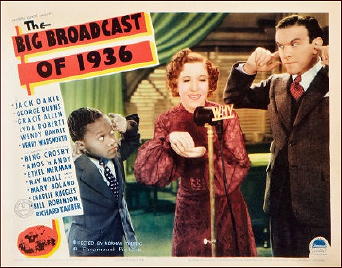Fri 25 May 2012
THE BIG BROADCAST and THE BIG BROADCAST OF 1936 – Reviewed by Dan Stumpf.
Posted by Steve under Films: Comedy/Musicals , Reviews[3] Comments
THE BIG BROADCAST (Paramount, 1932) should have been revived in the 60s for the benefit of the Drug Culture. Its spacey, cartoonish moments impart the look and feel of a Max Fleischer cartoon to this live-action flick, including such delights as a cat, edited to move in rhythm to a swinging pendulum, who oozes under a door; a clock that grows a literal face; a radio speaker that turns into a crooning skull; Cab Calloway (who did music for a couple of Betty Boops) doing a drug-song complete with pantomime coke-snorting; and a covey of frenzied female fans who, upon spotting their idol (Bing Crosby) form a football line and rush him! As I say, pretty spacey. There’s also Burns and Allen (briefly) and some very enterprising sight gags.
THE BIG BROADCAST OF 1936 (Paramount — need I add the year?) features much less interesting material, but a likeably zany plot, with Jack Oakie, the year before Super Sleuth, improbably moustached, playing Lochinvar, the Great Lover of the Airwaves, abducted to the island kingdom of a Russian (I think) Countess, along with an invention called “The Radio Eye” which picks up events (primarily musical and comedy spots by a variety of performers) around the world. Inventors Burns & Allen(!) are hot on the trail of their creation, and Oakie has to contend with the lethal rivalry of C. Henry Gordon and Akim Tamiroff for the Countess’s affections. Very enjoyable.
Oakie, incidentally, was a mildly prominent star in the early 30s, who for some reason went out of style, though his persona was adopted by Bob Hope and (later) Jack Carson. Hope, Carson and Oakie always played cowards who fancied themselves Men of Action, Nerds who imagined they were Great Lovers, consistently unable to understand why everyone on Earth doesn’t love them.
With this in mind, Oakie was a Natural to play Mussolini in Chaplin’s The Great Dictator, and he did a fine job of it in his last great part. He can still be seen in small parts as late as The Wonderful Country, but the Golden Days were behind him.
Bob Hope shared most of Oakie’s persona, but where Oakie was the eternal Cheese, Hope was the inveterate Schnook, with a hungry vulnerability that Oakie never sought. He also looked slightly more like a Leading Man.
I particularly like Hope’s “Road” pictures, where he and Crosby send up Adventure Flicks with gay abandon. Road To Zanzibar for example, has a highly enjoyable fight between Hope and a Killer Ape, where both combatants use the corniest old wrestling Routines imaginable: Airplane spins, Body Slams, leg-holds, beating the ground in mock-agony, etc. etc.

THE BIG BROADCAST. Paramount, 1932. Bing Crosby, Stuart Erwin, Leila Hyams, Sharon Lynn, George Burns & Gracie Allen, The Mills Brothers. Director: Frank Tuttle.
THE BIG BROADCAST OF 1936. Paramount, 1935. Jack Oakie, George Burns & Gracie Allen, Lyda Roberti, Wendy Barrie. Director: Norman Taurog.
May 25th, 2012 at 8:25 pm
Jack Oakie wrote one of my favorite autobiographies. JACK OAKIE’S DOUBLE TAKE is full of behind the scenes stories and gives you a wonderful insight to life in Hollywood during that era.
Cab Calloway was a influence on animation. In CARTOONS KICK ASS, they discuss how many of the animators were fans of Calloway. They would take his movements and transfer it directly to a cartoon. BLUE BROTHERS brought him back into the public eye, but underground cartoonists were listening to him in the sixties.
May 25th, 2012 at 9:18 pm
I will be on the lookout for the Oakie book. I didn’t know about it before.
I’m also glad I found that Cab Calloway video. (Adding videos to blog posts is like having a new toy to play with.) I don’t recall seeing him in performance before, though I’m sure I have. But this one I found very enjoyable.
May 25th, 2012 at 10:45 pm
Cab remains one of my favorite singers of that era.
By the way, the CARTOONS KICK ASS is available on YouTube but it is X-rated so I did not include a link. Cab is in Part One about the 6:05 mark.